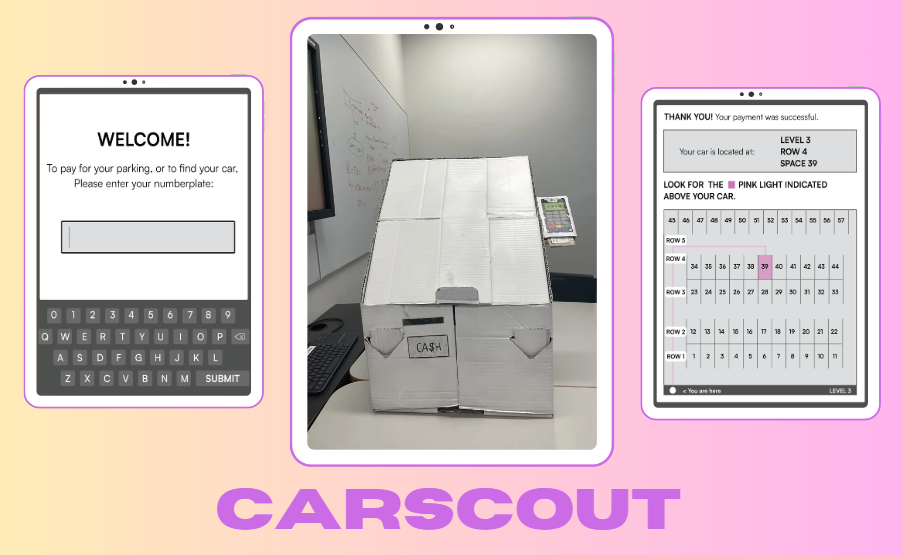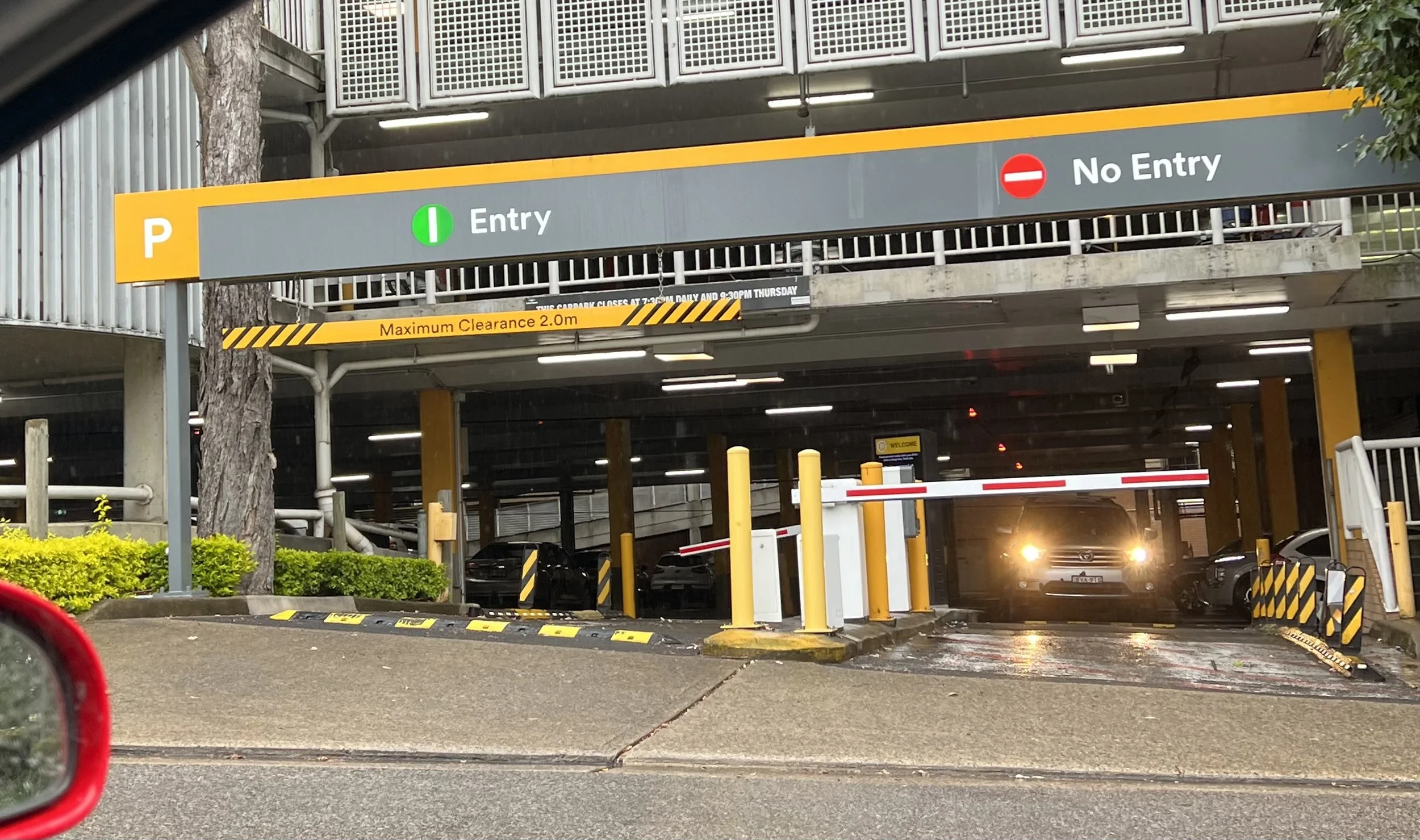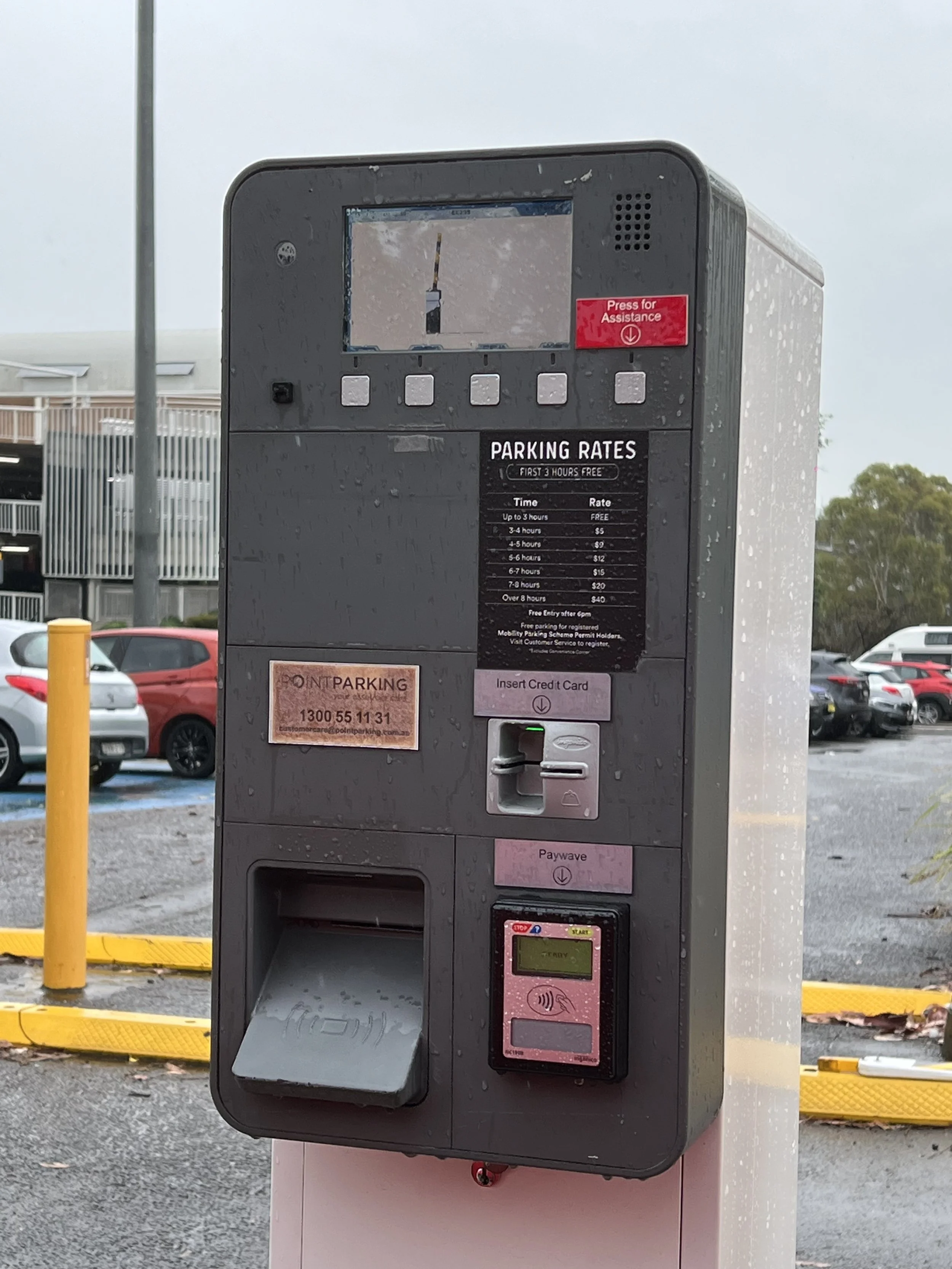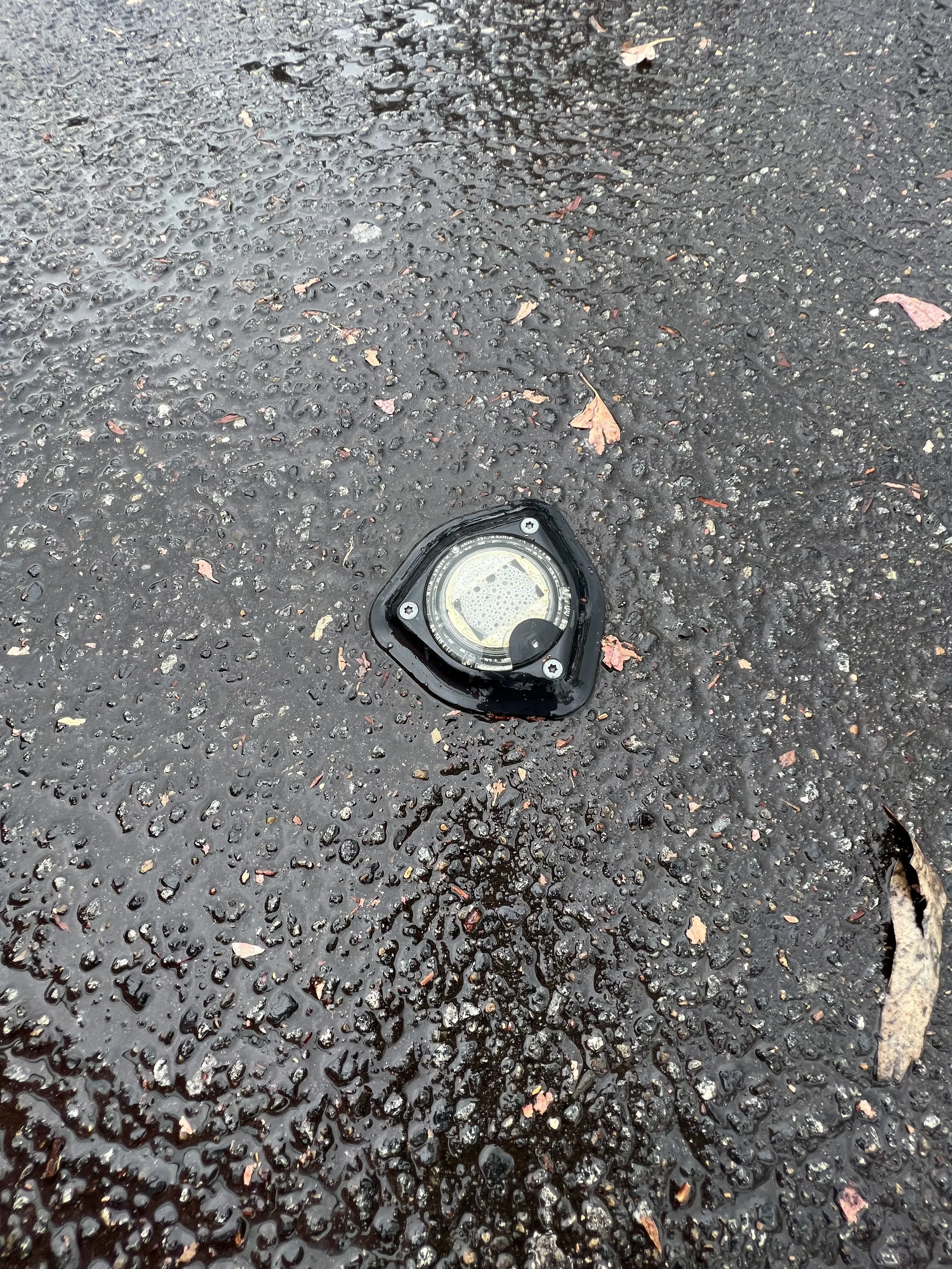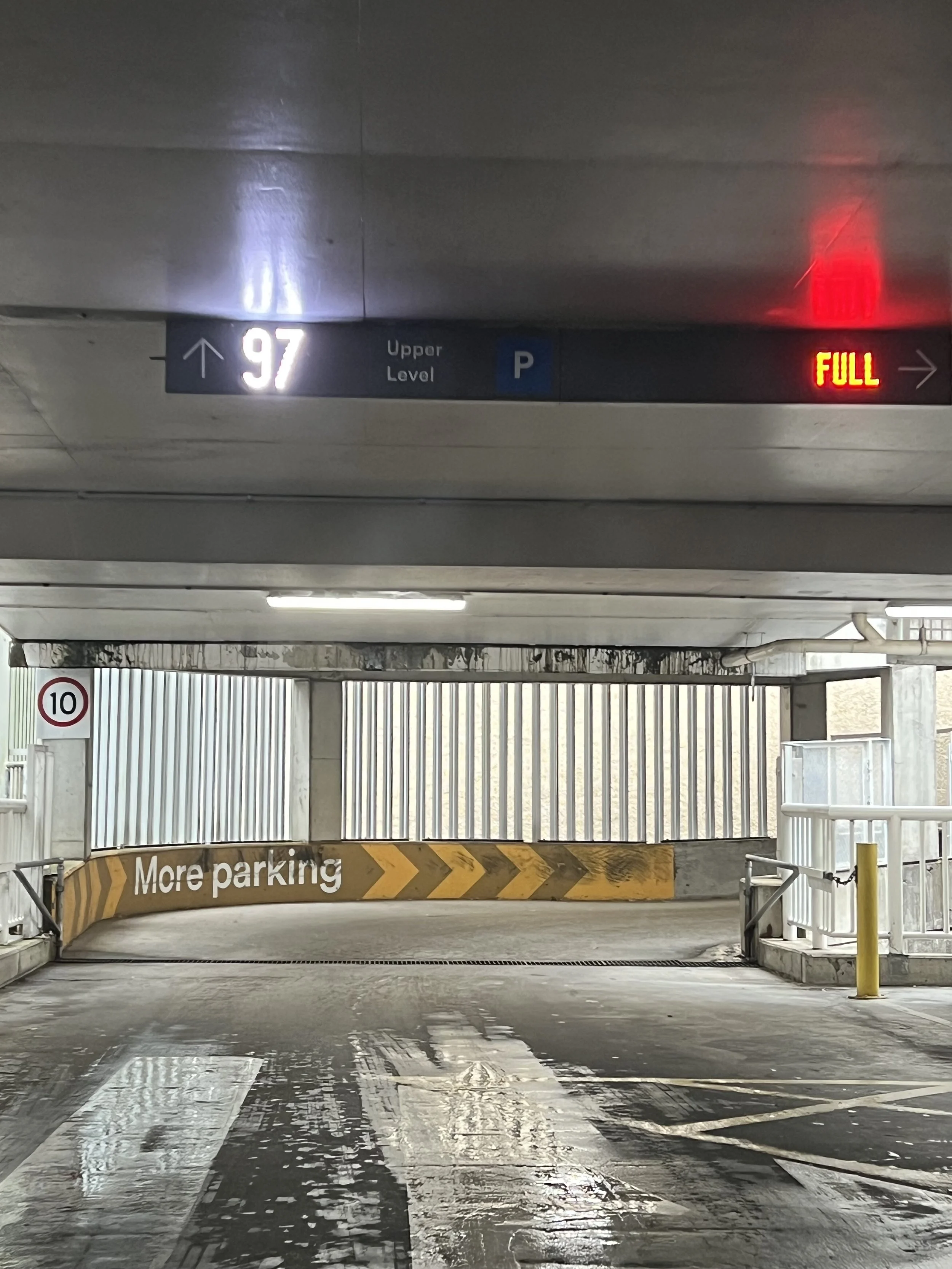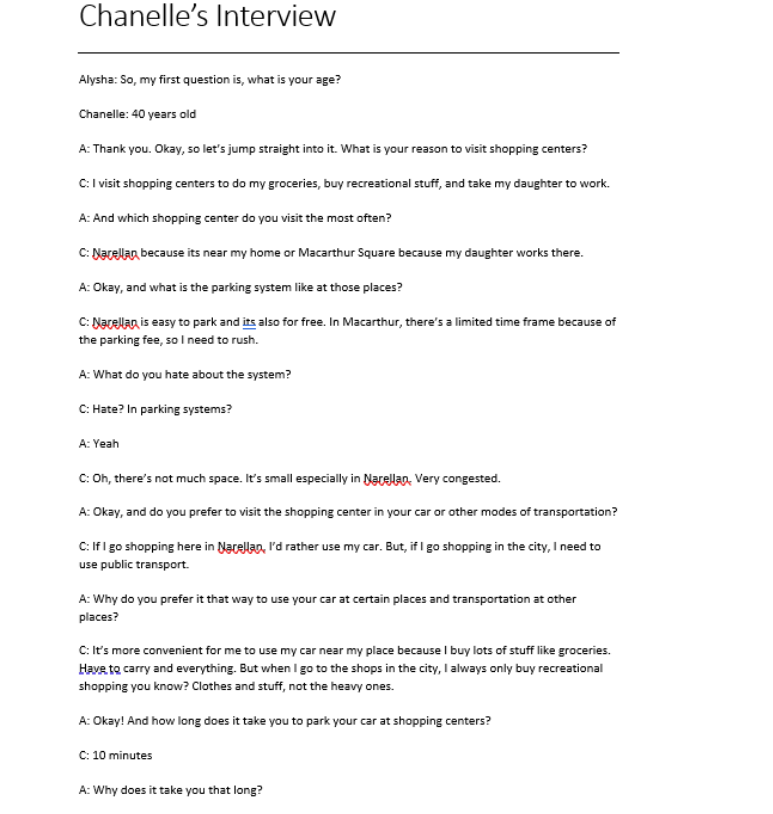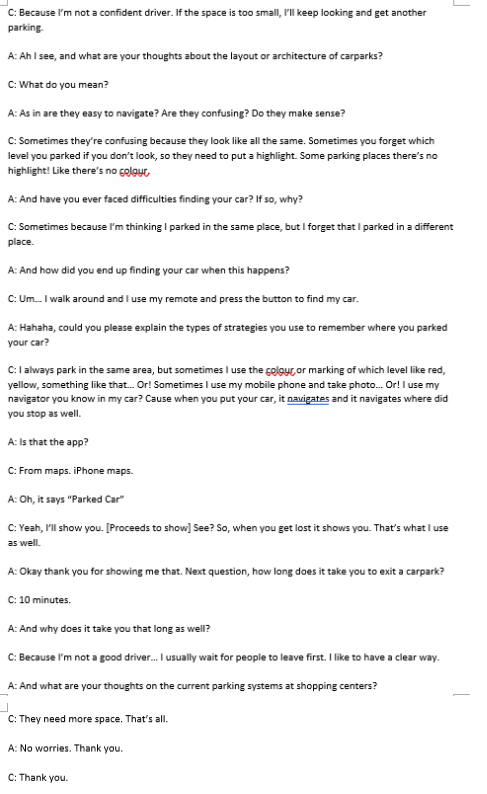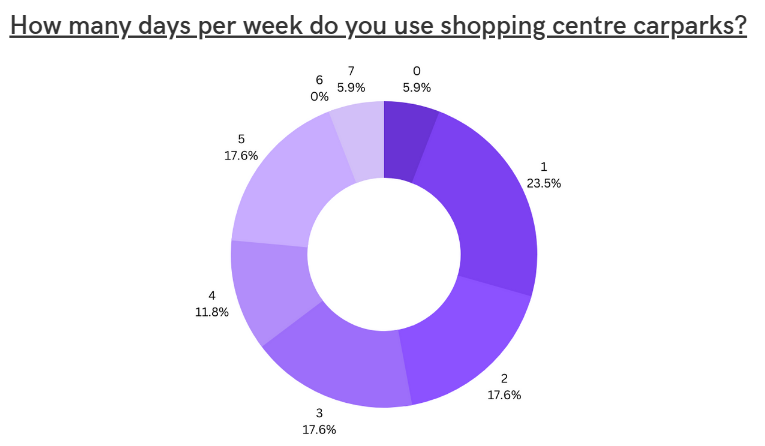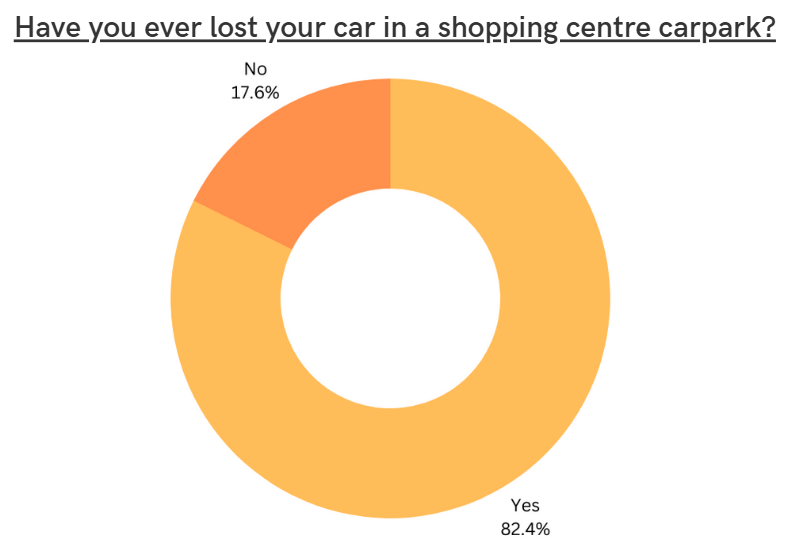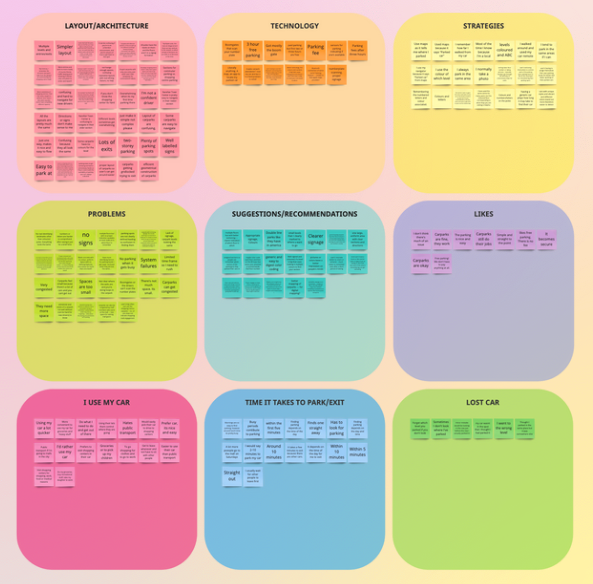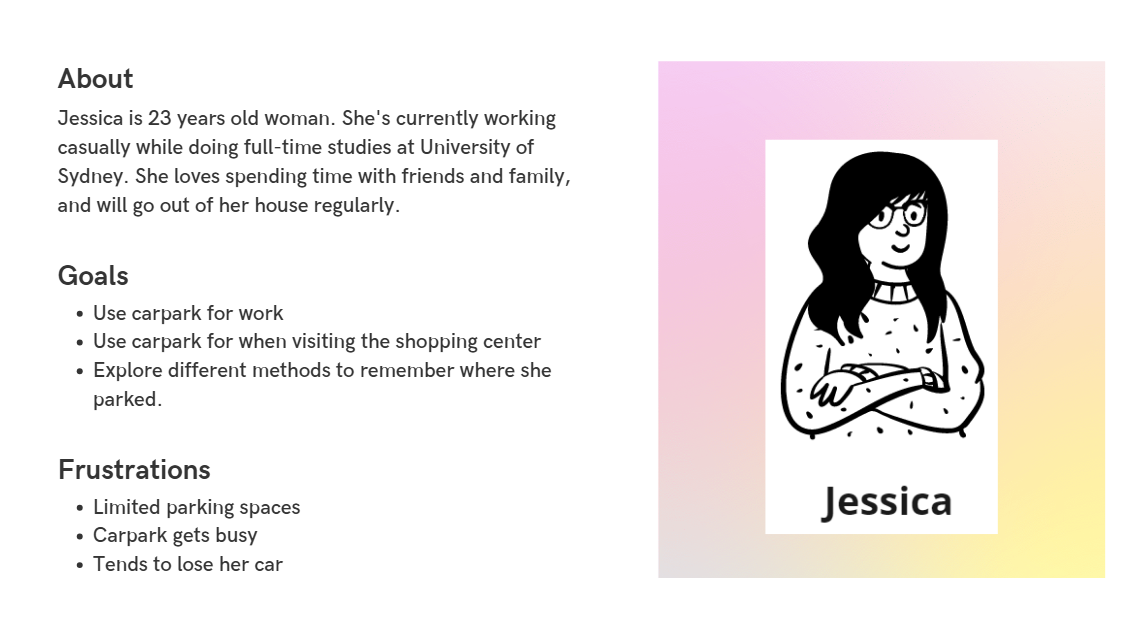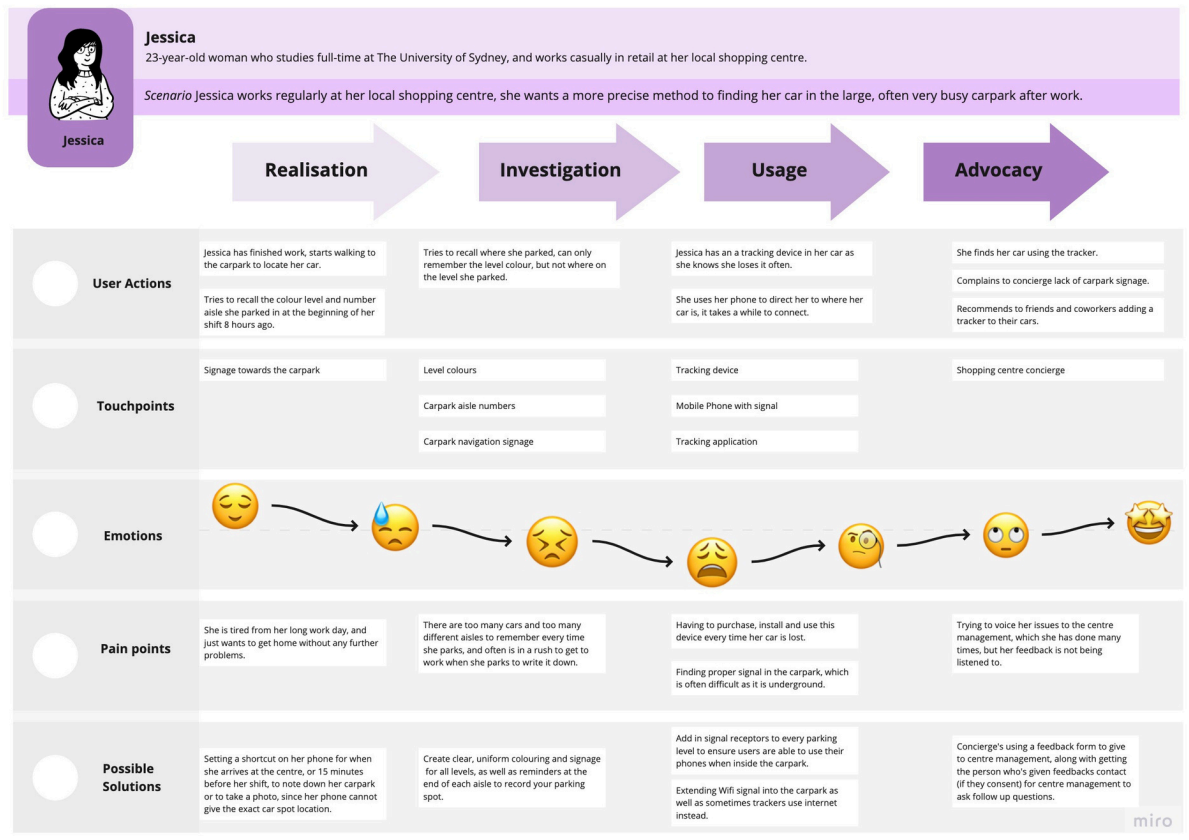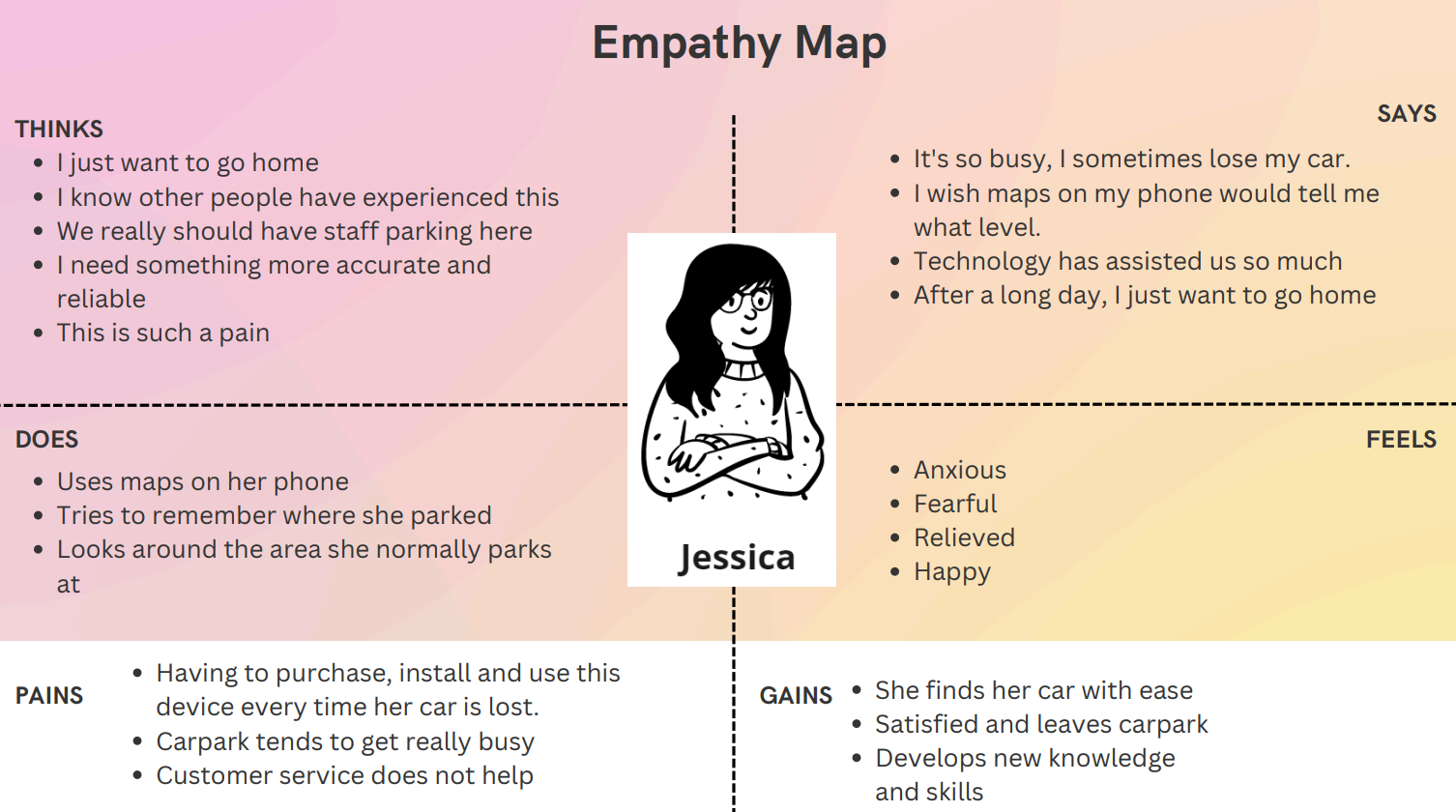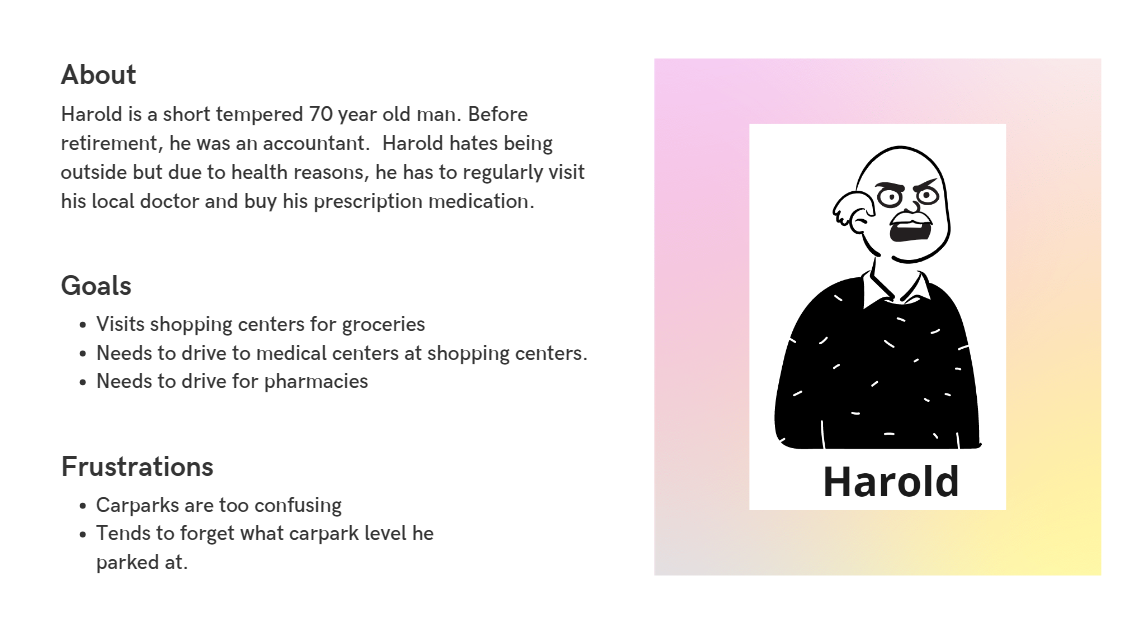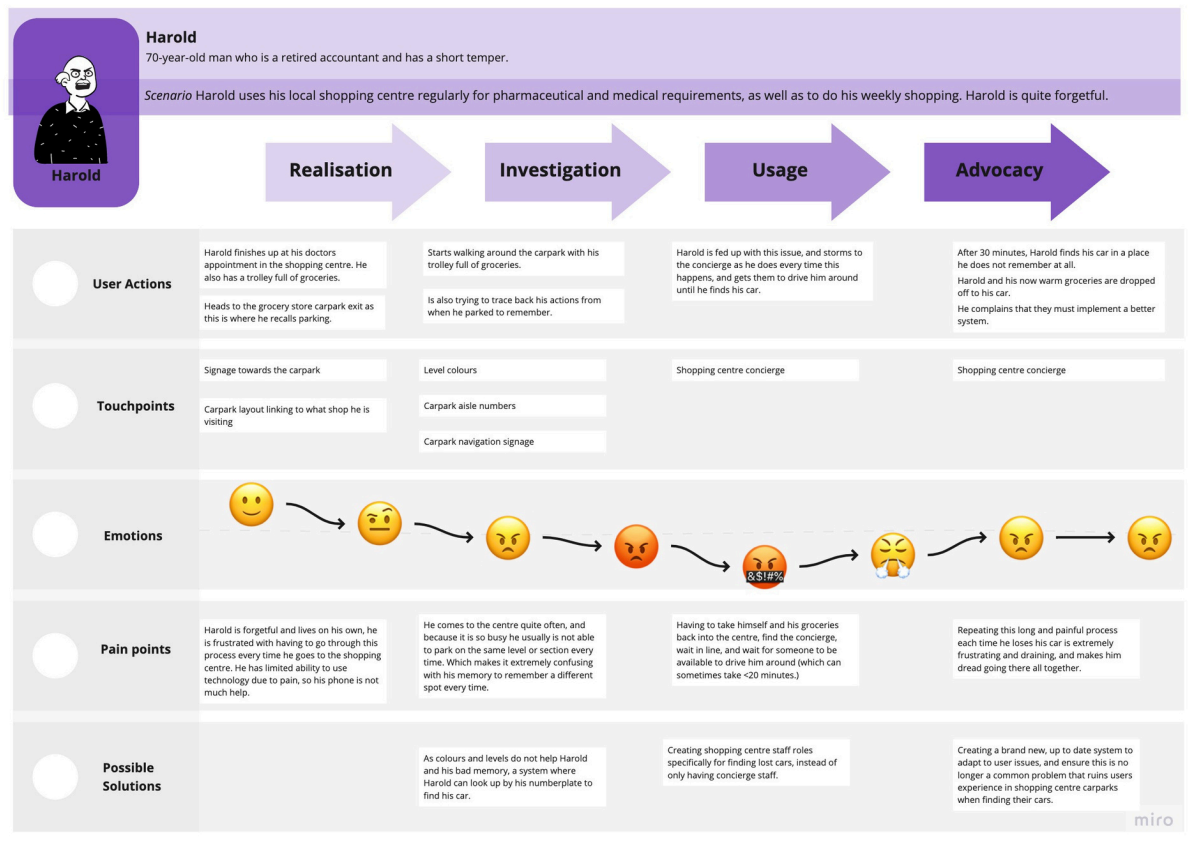research findings
spacial memory
Women were found to use landmarks as a remembrance whereas men used metric terms.
Almost two thirds of UK drivers forget where they park their car - according to a study conducted by NISSAN.
technology
Utilising available sensors in phones and cars along with accurate mapping.
spacial memory
Association vs precision - people are more likely to remember patterns.
According to Hankook Tire’s Seasonal Gauge Index - 55% of Americans have forgottem where they have parked their cars at least once.
technology
Licence plate scanners to record parking spots allowing user’s to input information into a kiosk.
problem statement
Investigate users thought processes and experiences finding their parked car.
Understand through people's experiences if and why there may be issues with finding your parked car in shopping centers.
research objective
observations
The first research method was observations. Features noticed included boom gates, number plate recognition, pay machines, sensors for free or taken parking, coloured and lettered pillars, and signage. The architecture consisted of underground, outside, and multi-levelled parking. When observing the behaviour of people, the majority knew exactly where their car was and where to go. At the time of this observation, it was 10am so the outside parking was not full, however parking to the entrance of the shopping center was completely full, and cars could be seen driving around looking for a spot.
Photos were taken at Macarthur Square's carpark.
Key observations were peopole's behaviours and actions, layout and architecture , technologies used, and parking strategies implemented.
Multiple interviews were held with a wide pool of user's to understand further the real dilemma with finding one's car at a shopping center parking lot. In total, 10 people were interviewed. Almost everyone interviewed had at least once in their lifetime found it difficult to remember their parking spots. Within these interviews, it was found that user's come up with their own unique techniques of remembering their spots.
These techniques include taking photos, using their phone maps, or writing down floor numbers.
interviews
A survey was created based on our problem statement and research objective to further our understanding, and identify user issues with shopping centre car parks. In total, 30 participants completed our survey.
surveys
Through surveys, interviews and observations we found that,
More than 80% of people have trouble finding their parked cars
The layout of a parking area is a leading cause of this problem
People use visual aids such as taking photos of the parking spot or signs to help remember
Problem
Ideas generated through our user research included,
Adding visual aid for better remembrance
Using technology to track cars within a parking area
Better and more apparent signage to assist in navigating through a parking area
Creating a one-spot help desk/kiosk to help people find their cars without too much extra work
solution
affinity diagram
The next step was to analyse and synthesise the data. Reading through all the survey and interview responses, we were able to come up with over 100 key data points. This then began the process of grouping into themes. As a result, 9 main themes were developed in which we then chose the top themes that related to our research objectives and created an insight for each of them.
The affinity diagram consisted of 8 interviewees, 100+ key data, 9 themes, and 6 insights.
The first 3 major themes chosen were layout/architecture, technology, and strategies. When looking at these insights, we understood that through excellent signage and directions, the layout of car parks can be understood and predicted by the users. Technology also enhances the flow and usage of car parks as they are constantly being improved and upgraded. However, when car parks lack these needs, users need to come up with strategies of their own in order to find their way around car parks or to find their car.
The next three major themes chosen were problems, suggestions/recommendations, and likes. When looking at these insights developed, we can see that car parks do their jobs in terms of providing parking for users especially with the assistance of technology, layout and signage. However, it can be understood that the experience of understanding the way certain car parks work depend on how well it is designed. Poorly made car parks create problems for the user in which they can become anxious, confused, and overwhelmed.
personas
concept ideation
In total, we came up with nine storyboards to share nine different solutions. To begin our process of elimination, we read and discussed each story. We then chose our favourites, and removed our leasts favourites before deciding on our chosen solution.
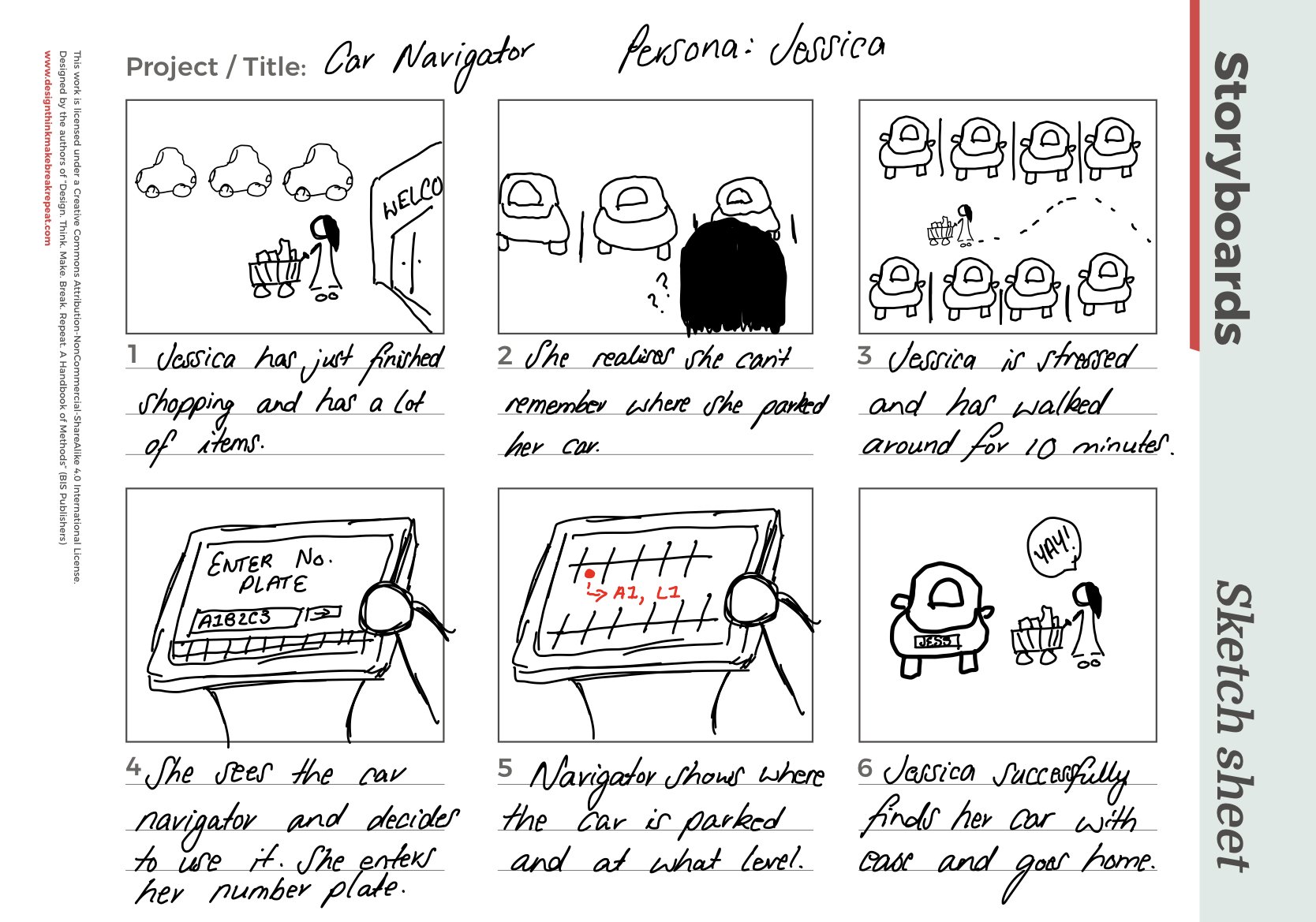
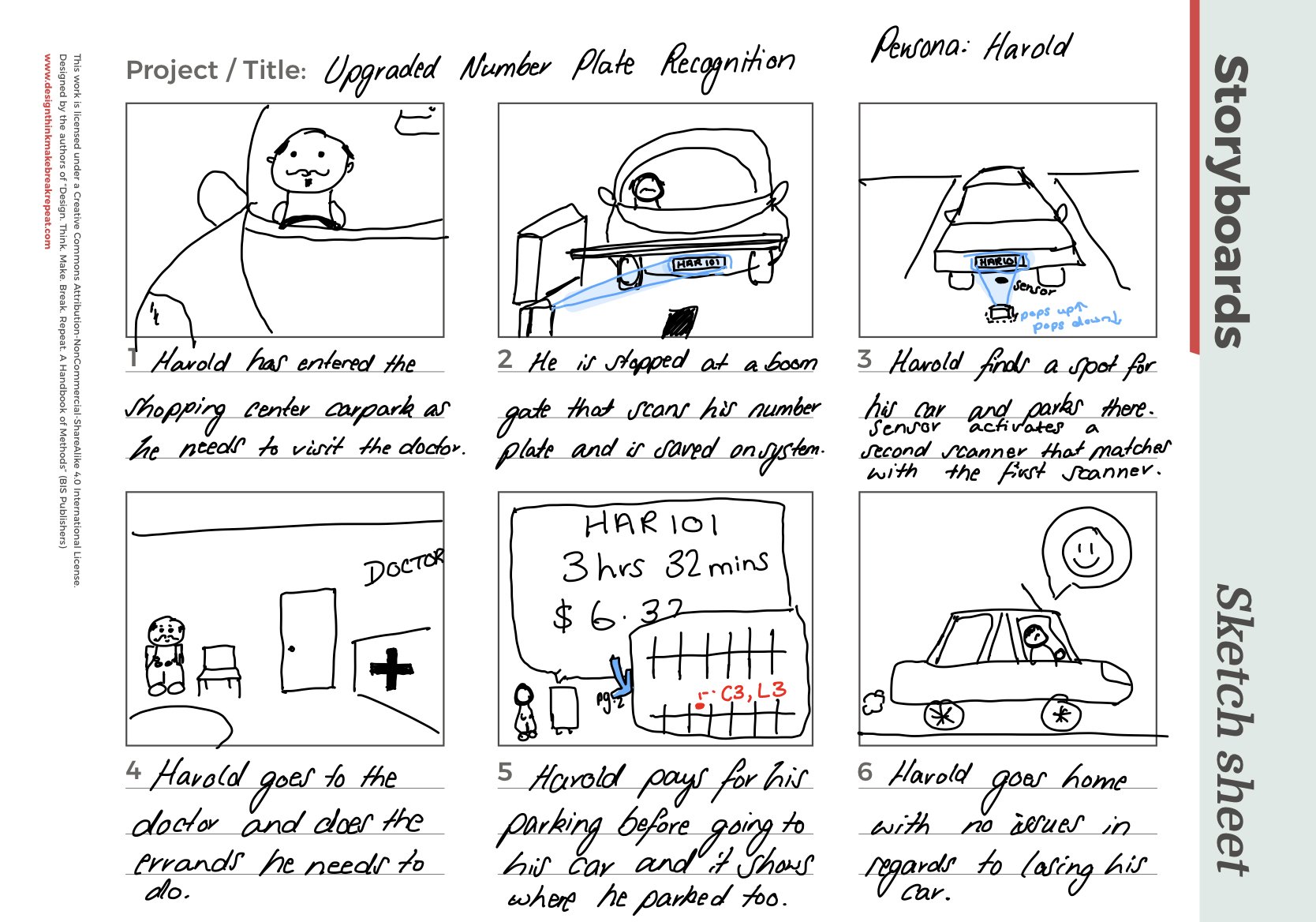







Concept Ideation.
quick sketches
After deciding on a solution, we listed down technologies that would be needed for the development of our solution. From there, we began sketching different versions of these products before deciding on a chosen sketch that would showcase our product.
our solution
The solution was developed by combining different features from the storyboards that we believed would compliment each other in assisting shoppers when finding their lost car. We decided that a kiosk was the best physical, spacial, and digital design to approach our problem. It would allow users to search for the car by entering their number plate that was previously scanned when entering the carpark boomgate and scanners. This idea is more advanced and further developed than today’s current technologies, as we decided to implement augmented reality, more scanners, and QR codes.
final concept
Here, I sketched up our final design concept which took into consideration user familiarity with current kiosks used in today. The kiosk consists of a large touch screen and keyboard when interacting with the given prompts, an eftpos machine to pay for parking if over the three hour free parking limit, an option to insert cash, and a large base for stable and guaranteed support. These kiosks would be placed at the entrance/exit of shopping centres.
carscout wireframes
mid-fidelity prototype
Kiosk
This model of the CarScout Kiosk is completely made of cardboard recycled from old boxes. The prototype was spray painted in white after being put together with hot glue and tape.
The prototype is clearly built differently, however the same features from the solution are applied to the prototype. A4 prompt cards were also printed to be placed on the kiosk during user testing.
Carpark Model
A carpark model was developed for the user testing, in where each participant was given a scenario. In order to act out the scene, we gave them the opportunity to drive into a carpark, go shopping, and pretend to forget where they parked their car. This led to the use of the kiosk.
The carpark was created through the use of an old shoebox lid, paint, chalk, and cardboard scraps. To make the testing more realistic, car toys were used.
hi-fidelity video
The amount of feedback for CarScout was valuable and we implemented the recommendations and suggestions into the Hi-Fidelity.
Key suggestions included:
Bright flashing light above car with a dedicated colour to the person so they know which location is theirs in the situation that another person is on the same level using another kiosk.
QR codes that allow users to open and preview the map on their phone so they don’t forget (alternatively they can use augmented reality and follow the directions on their phone).
Below is a walkthrough video of the service. We used a current kiosk used in carparks which do not belong to us. We just edited the video to show what our additional features would look like when being used by the user.
